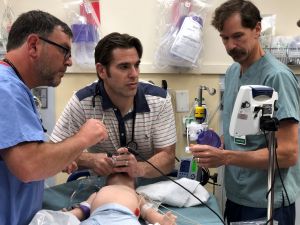June 6, 2019
June 6, 2019

Emergency responders and paramedics notify Cooley Dickinson’s Emergency Department whenever they are en route to the hospital with a patient. This alert, called an EMS notification, tells the ED staff what to expect and how to prepare for the incoming patient.
Recently, clinicians representing a variety of medical specialties at Cooley Dickinson “responded” to the following scenario:
A 5-year-old female was found without a pulse and not breathing in a pool. The mother left the child briefly to answer the phone. EMS personnel have been performing CPR for 5 minutes. No IV established; no meds have been given. Arriving in 1 minute.
While this “patient” didn’t arrive by ambulance this time, a Cooley Dickinson pediatric interdisciplinary response team had gathered and was ready to provide the life-saving care this patient would had needed had this been a real-life event.
Employees treat kids at Cooley Dickinson simulated four different pediatric emergencies recently, including the one above, thanks to a mobile simulation program that helps clinicians care for critically ill children in a clinical setting.
Preparing for Pediatric Emergencies
That program, led by a team from the Boston Medical Center COMET – Community Outreach Mobile Education Training – COMET Medical Director Barbara M. Walsh, MD, FAAP, and COMET Associate Program Director Marcie Gawel, MSN, MS, BS – simulated this drowning scenario and three others to help immerse staff in plausible pediatric emergencies in a learning environment.
“Critically ill pediatric visits are a high risk/low-frequency event,” said Emergency Department Physician Khama Ennis, MD. These types of events are challenging to the most experienced care teams, yet “running scenarios like these using in-situ simulation allows the care team to be better prepared.
“We have always been able to care for these patients, but this training will enable us to do an even better job,” added Ennis.
A Multi-disciplinary Approach
Staff from the Emergency Department as well as the Childbirth Center, Pediatrics, Respiratory Therapy, Pharmacy and the Hospitalists program participated in the simulation training. Any code or resuscitation involves staff from multiple departments, all of whom have important roles.
Noted Ennis, “pediatric resuscitations especially often pull in support from the Childbirth Center and inpatient pediatrics who don’t normally spend much time in the ED. Additionally, since we do have an inpatient pediatric unit, it is important that they are able to care for patients if they become unstable upstairs on the unit.”
In addition to the educational component, the training allows staff to see our opportunities for improvement in materials and layout. Said Ennis, “we are also able to benefit from the insights of a team of instructors who have run this program in dozens of hospitals and gleaned best practices that they can share. If we can adopt some of their suggestions, the care we provide can only get better. We are able to strengthen our approaches to communication in critical scenarios.”
“We want the best for this community and its children.”
Ennis points to the increased frequency over recent years of simulation to improve education and preparedness for critical scenarios.
“Our patients, community and care teams will benefit from running this program,” she said. “We are very excited to have launched this simulation training as part of our goal to improve the care of pediatric patients at CDH.”
“While we hope we never have to use these skills, this training makes us better at what we do. We all want the best for this community and its children!”

